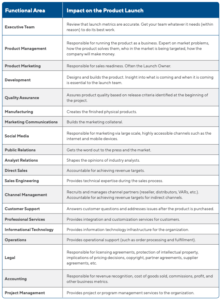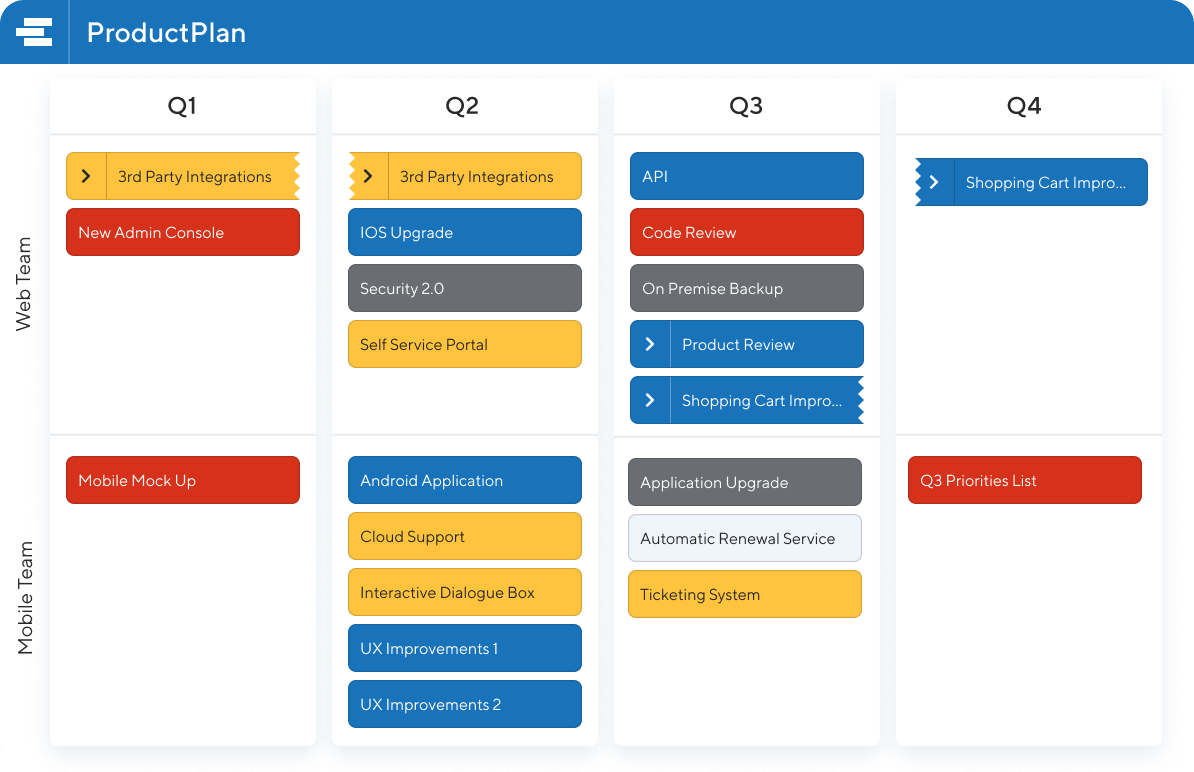The product launch activities will include the involvement of most department representatives in your organization.
Product Launch Kickoff
Who needs to be in your product launch kickoff?
The upcoming product launch activities will include the involvement of representatives from most departments in your organization. Although they may not be assigned any tasks until the final stages of the launch, it’s essential to have every stakeholder identified and included upfront at the product launch kickoff. Not all teams need to be involved/represented in the product launch kickoff, but there should be clear communication regardless.

____________________
1 http://mediafiles.pragmaticmarketing.com/Framework-Files/LeadersGuide_1307.pdf
Product launch kickoff meetings can run longer than other meetings. When you’re ready to schedule a meeting, 90 minutes will be enough to do everything while leaving time for any housekeeping items.
When everyone is all together, the first thing to do is inform each representative that they’re speaking on behalf of their department. Once you get confirmation that each individual represents their department, select someone to take notes throughout the meeting. A visual of how each department will contribute to the launch can be a great asset at this stage t.
When everyone is onboard from day one, no one can claim they were unaware of things further down the road. It also offers them an opportunity to chime in with ideas and opinions earlier in the process instead of second-guessing things further down the line. By inviting them into the feature launch kickoff process, they know they’re valued and have something to contribute.
Ensure all attendees know what the product kickoff meeting is for and what the ideal outcomes should be before leaving the room. Then address everyone’s roles, what they are actively responsible for, and how you anticipate everyone working together.
Kickoff communication
Before the meeting wraps up, let everyone know how you’ll be communicating any future next steps, whether in meetings, online video chat, in the roadmap, or notes. Some product launch kickoffs can occur months or even years out from the eventual product launch, so you’ll want to set up a good system for future communication.
Remember, you don’t want to alienate anyone in the meeting. The fastest way to estrange anyone is by speaking in the terminology they don’t understand. Try to be conscientious of not over-using your favorite acronyms. It adds a tiny bit of extra work for you to be inclusive but will help you leaps and bounds later on. Take the time to explain the concept and state that it will be a recurring topic. This cues the opportunity for questions and makes it clear that you aren’t just throwing acronyms out there for the sake of it.
Emphasize the value of the product
At this early stage, your product launch kickoff should focus entirely on the new product’s value (or the next version) will deliver to customers. The details are likely to change, so it’s better to avoid confusing functionalities with overarching value.
During the kickoff, harken back to the vision, themes, and goals of the product. These should become the emphasis for a successful launch. This conversation will drive messaging, channels, activities, and target audiences.
The kickoff conversations should answer the following questions for meeting members.
- What problems is the product solving?
- How does this align with the company vision?
- What pain points is it addressing?
- Whom is it helping?
- Why are we building this?
At the same time, it’s a good idea to come to terms right away because your product won’t be all things to all people.
Getting too aggressive with your goals from the get-go usually leads to product failure and disappointment. While your organization can have lofty goals of world domination, an individual product release can only do so much. Accepting that this product will not be all things to all people upfront helps temper organizational expectations.
Delay the product details
Launch kickoffs can be months or years before the actual product launch. As such, avoid getting deep into any specifics. With so much time between now and when the product ultimately is released, there are bound to be tweaks and changes along the way.
Couching the product strategy in themes gets people out of the habit of focusing on specific functionality and back to primary objectives. The goal is to communicate the why more than the what. Work with your team to understand the why and the jobs to be done before development begins to commit time and resources.
You should still deliver something solid in terms of commitment, though. That commitment can sound like, “When delivered, our customers will be able to x,y, and z.”
The early stages are more about roles and responsibilities and less about the details of implementation and execution. For instance, avoid conversations around pixels and buttons. Because you’ve got such a head start, there will be plenty of opportunities to flesh out those topics at a later date.
Then, conduct a product launch pre-mortem where your product launch kickoff team thinks through possible missteps that could hurt your product launch and prepare plans of action in advance. Knowing there are strategies in place (understood by others, not just you) relieves pressure for if/when something goes awry.
